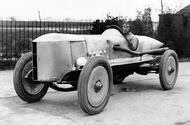What makes a car brand confusing? If you’re pondering this question, Talbot might just top the list. The story of this car manufacturer is a winding road filled with twists, turns, and a fair share of identity crises. Let’s take a closer look at how Talbot’s journey unfolded, revealing a fascinating tale of ambition, innovation, and, ultimately, confusion.
How Did Talbot Begin Its Journey?
The roots of Talbot stretch back to 1888 when Charles Chetwynd-Talbot, the 20th Earl of Shrewsbury, established a taxi firm in London. What set this venture apart was the use of pneumatic tires, a novel invention at the time. Fast forward a few years, and in 1896, the Earl partnered with Adolphe Clément, a savvy businessman who had made his fortune from tires and bicycles. Together, they began selling Clément’s cars in London, marking the start of a complex relationship that would lead to the birth of the Talbot brand.
By 1902, the duo rebranded their cars as Clément-Talbot, but just a year later, they decided to split their operations. The Earl would handle the Talbot-branded cars in Britain, while Clément focused on his own brand in France. Ironically, this separation was meant to reduce confusion among consumers, but it only set the stage for a much more tangled narrative.
What Made Talbot Stand Out?
Talbot quickly gained a reputation for performance and reliability, earning the nickname “Invincible Talbot.” A significant milestone came in 1913 when Percy Lambert became the first person to achieve a speed of 100 miles per hour in a Talbot, a feat that captured the public’s imagination. However, the onset of World War I disrupted production and left both the London and Paris firms struggling to regain their footing.
In 1919, the Earl sold his company to Darracq, a British-owned French manufacturer, while Clément sold his factory to André Citroën. This marked the beginning of a new chapter for Talbot, as the brand continued to evolve. The new owners retained the Talbot name for cars produced in London and introduced the Talbot-Darracq label for those made in Paris. The acquisition of Wolverhampton’s Sunbeam added another layer to the brand’s already complicated identity.
How Did Talbot Navigate the Challenges of the 1930s?
The 1930s brought both triumph and turmoil. Talbot made headlines at the Le Mans 24-hour race, outperforming renowned competitors like Bentley and Bugatti with its 2.3-litre 90s. Yet, the economic depression that followed took a toll on the automotive industry, and the STD Motors group, which included Talbot and Sunbeam, struggled to survive.
In a bid to revive the brand, Rootes, the owner of Hillman and Humber, stepped in to rescue Talbot and Sunbeam. This partnership seemed promising, with Autocar proclaiming that Talbot would continue to thrive under new management. However, the narrative took another twist when the managing director, Antonio Lago, bought out the Talbot-Darracq business, leading to a split where Talbot produced more modest vehicles while Talbot-Lago focused on luxury and performance.
What Happened to Talbot in the Post-War Era?
The post-war years saw further confusion as Rootes merged Talbot and Sunbeam, creating yet another hyphenated name: Sunbeam-Talbot. While both brands enjoyed some success in the 1950s—Talbot-Lago achieving victories in grands prix and Sunbeam-Talbot gaining acclaim for its stylish saloons—the confusion around the names persisted. Rootes eventually simplified the name to just Sunbeam in 1954, but the legacy of Talbot-Lago was cut short in 1959 due to economic pressures.
The saga didn’t end there. Both Simca and Rootes would eventually fall under Chrysler Europe, and when PSA took over in 1979, Talbot was seen as a brand ripe for revival. The reasoning? It had a strong image in the eyes of the public, perceived as both British and French. Unfortunately, the revival didn’t last long, as new models failed to resonate with consumers, leading to Talbot’s final demise with the Express van in 1994.
What’s the Takeaway from Talbot’s Story?
The tale of Talbot is a testament to the complexities of branding in the automotive world. From its innovative beginnings to its confusing legacy, the brand’s journey reflects the challenges of maintaining a clear identity in a rapidly changing market.
So, what’s the big takeaway? Talbot’s history isn’t just about cars; it’s about navigating the twists and turns of business, innovation, and consumer perception. If there’s one lesson to glean from this, it’s that clarity and adaptability are crucial in any venture. Whether you’re a car enthusiast or just curious about automotive history, Talbot’s story reminds us that sometimes, the road to success is anything but straightforward.

